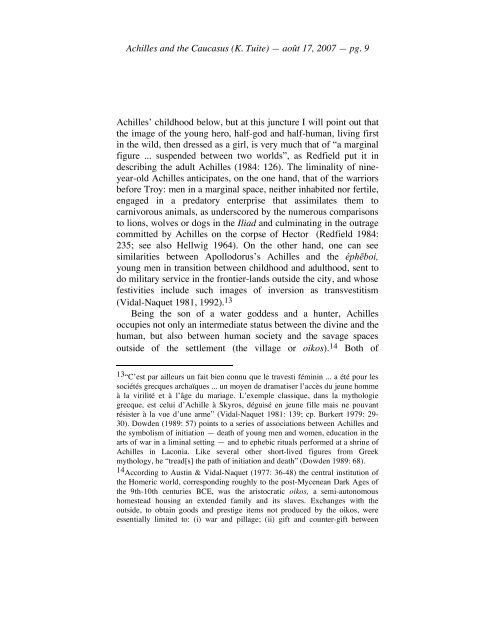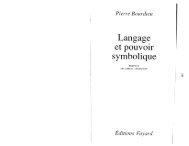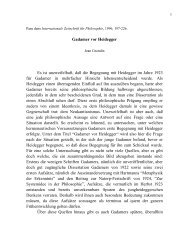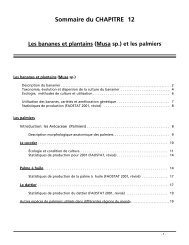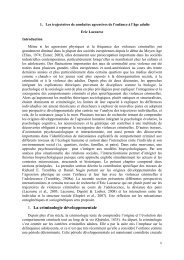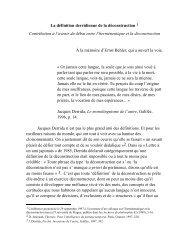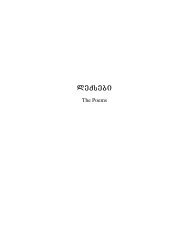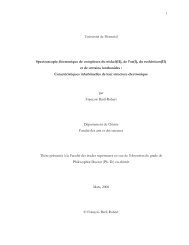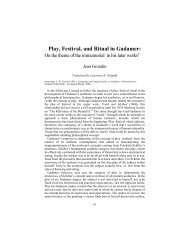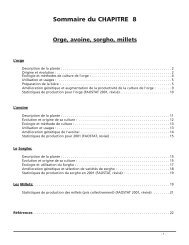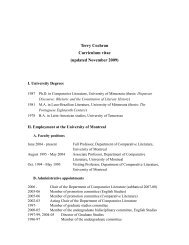Achilles and the Caucasus - Université de Montréal
Achilles and the Caucasus - Université de Montréal
Achilles and the Caucasus - Université de Montréal
Create successful ePaper yourself
Turn your PDF publications into a flip-book with our unique Google optimized e-Paper software.
<strong>Achilles</strong> <strong>and</strong> <strong>the</strong> <strong>Caucasus</strong> (K. Tuite) — août 17, 2007 — pg. 9<br />
<strong>Achilles</strong>’ childhood below, but at this juncture I will point out that<br />
<strong>the</strong> image of <strong>the</strong> young hero, half-god <strong>and</strong> half-human, living first<br />
in <strong>the</strong> wild, <strong>the</strong>n dressed as a girl, is very much that of “a marginal<br />
figure ... suspen<strong>de</strong>d between two worlds”, as Redfield put it in<br />
<strong>de</strong>scribing <strong>the</strong> adult <strong>Achilles</strong> (1984: 126). The liminality of nineyear-old<br />
<strong>Achilles</strong> anticipates, on <strong>the</strong> one h<strong>and</strong>, that of <strong>the</strong> warriors<br />
before Troy: men in a marginal space, nei<strong>the</strong>r inhabited nor fertile,<br />
engaged in a predatory enterprise that assimilates <strong>the</strong>m to<br />
carnivorous animals, as un<strong>de</strong>rscored by <strong>the</strong> numerous comparisons<br />
to lions, wolves or dogs in <strong>the</strong> Iliad <strong>and</strong> culminating in <strong>the</strong> outrage<br />
committed by <strong>Achilles</strong> on <strong>the</strong> corpse of Hector (Redfield 1984:<br />
235; see also Hellwig 1964). On <strong>the</strong> o<strong>the</strong>r h<strong>and</strong>, one can see<br />
similarities between Apollodorus’s <strong>Achilles</strong> <strong>and</strong> <strong>the</strong> éphēboi,<br />
young men in transition between childhood <strong>and</strong> adulthood, sent to<br />
do military service in <strong>the</strong> frontier-l<strong>and</strong>s outsi<strong>de</strong> <strong>the</strong> city, <strong>and</strong> whose<br />
festivities inclu<strong>de</strong> such images of inversion as transvestitism<br />
(Vidal-Naquet 1981, 1992). 13<br />
Being <strong>the</strong> son of a water god<strong>de</strong>ss <strong>and</strong> a hunter, <strong>Achilles</strong><br />
occupies not only an intermediate status between <strong>the</strong> divine <strong>and</strong> <strong>the</strong><br />
human, but also between human society <strong>and</strong> <strong>the</strong> savage spaces<br />
outsi<strong>de</strong> of <strong>the</strong> settlement (<strong>the</strong> village or oikos). 14 Both of<br />
13 “C’est par ailleurs un fait bien connu que le travesti féminin ... a été pour les<br />
sociétés grecques archaïques ... un moyen <strong>de</strong> dramatiser l’accès du jeune homme<br />
à la virilité et à l’âge du mariage. L’exemple classique, dans la mythologie<br />
grecque, est celui d’Achille à Skyros, déguisé en jeune fille mais ne pouvant<br />
résister à la vue d’une arme” (Vidal-Naquet 1981: 139; cp. Burkert 1979: 29-<br />
30). Dow<strong>de</strong>n (1989: 57) points to a series of associations between <strong>Achilles</strong> <strong>and</strong><br />
<strong>the</strong> symbolism of initiation — <strong>de</strong>ath of young men <strong>and</strong> women, education in <strong>the</strong><br />
arts of war in a liminal setting — <strong>and</strong> to ephebic rituals performed at a shrine of<br />
<strong>Achilles</strong> in Laconia. Like several o<strong>the</strong>r short-lived figures from Greek<br />
mythology, he “tread[s] <strong>the</strong> path of initiation <strong>and</strong> <strong>de</strong>ath” (Dow<strong>de</strong>n 1989: 68).<br />
14 According to Austin & Vidal-Naquet (1977: 36-48) <strong>the</strong> central institution of<br />
<strong>the</strong> Homeric world, corresponding roughly to <strong>the</strong> post-Mycenean Dark Ages of<br />
<strong>the</strong> 9th-10th centuries BCE, was <strong>the</strong> aristocratic oikos, a semi-autonomous<br />
homestead housing an exten<strong>de</strong>d family <strong>and</strong> its slaves. Exchanges with <strong>the</strong><br />
outsi<strong>de</strong>, to obtain goods <strong>and</strong> prestige items not produced by <strong>the</strong> oikos, were<br />
essentially limited to: (i) war <strong>and</strong> pillage; (ii) gift <strong>and</strong> counter-gift between


